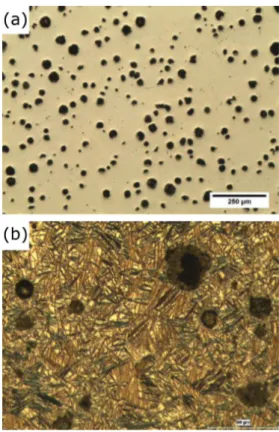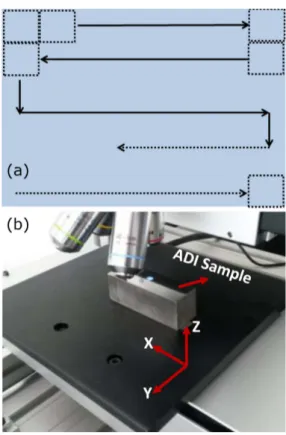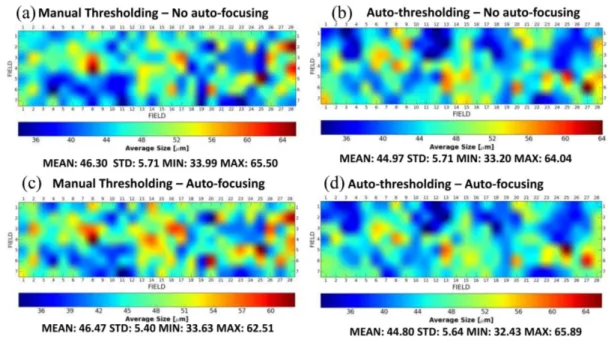Vol. 135 (2019) ACTA PHYSICA POLONICA A No. 4
Special Issue of the 8th International Advances in Applied Physics and Materials Science Congress (APMAS 2018)
Investigating the Effect of Auto-Focus and Auto-Threshold
Algorithms in Advanced Nodularity Analysis
of Austempered Ductile Iron Castings
B. Çetin
a,∗, H. Kurtuldu
b, G. Durkaya
cand K. Davut
caFNSS Defense Systems Co. Inc., Engineering and Research Department, Ankara, Turkey bBaskent University, Department of Biomedical Engineering, Ankara, Turkey cAtılım University, Department of Metallurgical and Materials Engineering, Ankara, Turkey Austempered ductile iron castings have a wide range of application fields including defense and heavy-duty industries due to their promising mechanical properties. Austempered ductile iron castings could provide excellent combination of high strength, toughness, and wear resistance at the same time. Unlike other spheroidal ductile cast irons, austempered ductile iron castings need to be processed by a special austempering heat treatment which enables the verification of the conformity of the nodularity level after the casting operations. Previous studies have shown that wide area mappings for determining nodularity are crucial to eliminate the representativeness problems. In this sense, some precautions should be taken for the accuracy of results in large scale nodularity examination. In this study, the effect of auto-thresholding and auto-focusing algorithms on the advanced nodularity analysis is investigated. The results suggest that auto-thresholding and auto-focusing methods have significant contributions for determining average nodularity levels and average graphite sizes.
DOI:10.12693/APhysPolA.135.762
PACS/topics: auto-threshold, auto-focus, image analysis, nodularity analysis, austempered ductile iron castings
1. Introduction
Due to strict design requirements, there is a continuous demand for improving new alternative materials which exhibit promising mechanical properties. Particularly, si-multaneous results in both high strength and durability play important roles in the defense industry where the service conditions are severely compelling. Austempered ductile iron (ADI) is a specific type of spheroidal graphite cast iron (SGCI) grade with attractive mechanical prop-erties such as higher tensile, fatigue strength, toughness and relatively good ductility which make it superior to the other grades of ductile irons [1–3]. Furthermore, ADI has a higher specific strength value due to its lower den-sity compared to steel [4, 5]. Therefore, it can also serve as a light-weight material compared to forged steel or steel castings.
ADI is obtained after a specific heat treatment of SGCI which is known as austempering operation. Ausing process includes two steps: austenization at temper-atures around 850◦C to 950◦C, followed by rapid cool-ing to an isothermal transformation temperature range (220◦C–420◦C) for 1 to 4 h before coming to room tem-perature [6, 7]. A specific microstructure called ausfer-rite occurs as a result of this austempering heat treat-ment. Ausferrite is basically composed of acicular fer-rite and carbon enriched austenite phases. The typ-ical microstructure of an ADI material is illustrated in Fig. 1a and b.
∗corresponding author; e-mail: cetin.baris@fnss.com.tr
Fig. 1. Optical micrograph of (a) as-polished ADI sample (50×), (b) an etched sample (200×).
The matrix microstructure of ADI as well as the graphite morphology should be proper for the desired mechanical properties. The insufficient nodularity (cir-cularity) of graphite particles results in lower strength
Investigating the Effect of Auto-Focus and Auto-Threshold Algorithms. . . 763 and ductility values. For instance, the ISO-17804
stan-dard recommends at least 85% nodularity to achieve the desired mechanical properties of ADI. The correlation between the strength of SGCI and the graphite nodu-larity is also a well-known fact in metallurgical engineer-ing [8, 9]. Considerengineer-ing costly and time-consumengineer-ing (1–4 h) austempering operations, determining the nodular prop-erties of ADI materials beforehand is essential. Previous studies have shown that the investigation over large sur-faces is necessary in order to eliminate representativeness problems [7]. Topological (e.g., height variations on the surface) and optical (e.g., brightness differences among images) effects need to be minimized in the nodularity analysis performed by wide area scanning. In this study, we propose a novel method to investigate the nodularity of ADI materials in large surface areas. Auto-focus and auto-thresholding algorithms are studied and compared with the conventional techniques (manual thresholding and no auto-focusing) already used in industrial applica-tions for nodularity analysis.
2. Experimental procedure
As delineated in Fig. 2a and b, the surface of an ADI sample is raster scanned using a metallurgical micro-scope (AUTOMET PSARON HTI) at 196 points cor-responding to a total scan area of nearly 223 mm2.
Op-tical images for nodularity analysis are acquired at each scan point.
Fig. 2. (a) Raster scanning methodology of the ADI sample, (b) AUTOMET optical microscopy system.
Each image is processed and analyzed according to the ASTM E2567 standard, where graphite particles are clas-sified based on intensity (image contrast), particle size (maximum Feret’s diameter: MFD), and shape factor (SF). Only the graphites which have met the minimum cross-sectional area requirement (MFD ≥ 10 µm) are ac-cepted as graphite particles. Furthermore, the particles which meet the nodularity criteria (with SF ≥ 0.6) are considered as nodular graphites. Each image in the scan is used to characterize the spatial distribution of nodular properties. Table I summarizes the experimental param-eters in the scanning analysis.
TABLE I Experimental parameters in scanning nodular analysis
Area of a single matrix field 1138368 µm
2
(≈ 1.14 mm2) Number of matrix fields analyzed 196 Total matrix area analyzed 223.44 mm2
Pixel calibration factor 0.85
The motorized stages in the microscopy system enable the raster scan to be made automatically in pre-defined areas. Moreover, the motorized Z-axis of the optical sys-tem provides an automatic control of the best focusing plane. At each image position, the system searches for the best focus by changing the Z position of the objective lens. The auto-thresholding is performed by a specifically designed software for the images. The Otsu method is used for auto-thresholding of the images to distinguish the graphite particles from the matrix structure (back-ground). This thresholding technique is a clustering-based method employed to minimize the intra-class vari-ance between black and white pixels [10, 11]. In this study, the nodularity on the 196 surface points of the ADI sample is analyzed by four different methods: (i) with manual thresholding and without auto-focusing, (ii) with manual thresholding and focusing, (iii) with auto-thresholding and without auto-focusing, and (iv) with auto-thresholding and auto-focusing.
3. Results and discussion
The average nodularity by area and average graphite size for 196 surface points of the ADI sample, calculated with manual thresholding and without performing auto-focusing, are shown in Figs. 3 and 4, respectively. It is seen that both values are not constant and fluctuate over the surface. For a visualization of the spatial depen-dence of the nodular properties, the average nodularity and the graphite size are color-coded from blue to red on the sample surface. Figure 5 demonstrates the average nodularity computed by four different methods in a 7×28 field grid corresponding to a physical area of 223.44 mm2.
Similarly, Fig. 6 illustrates how the average graphite size varies over the surface. The application of both the auto-focusing and auto-thresholding algorithms results in ap-proximately 5% change in the nodularity analysis.
764 B. Çetin, H. Kurtuldu, G. Durkaya, K. Davut
Fig. 3. Average nodularity for 196 surface point with manual thresholding and without auto-focusing.
Fig. 4. Average graphite size for 196 surface points with manual thresholding and without auto-focusing.
Fig. 5. Colormap representation of nodularity by area in 223.44 mm2 surface area (7 × 28 = 196 fields) with mean, standard deviation (STD), minimum (MIN) and maximum values (MAX) for four different analysis methods: (a) manual thresholding with no focusing, (b) thresholding with no focusing, (c) manual thresholding with auto-focusing and (d) auto-thresholding with auto-auto-focusing.
Investigating the Effect of Auto-Focus and Auto-Threshold Algorithms. . . 765 Since the nodular properties have a high spatial
de-pendence, the analysis at only a few points of the sur-face could lead to improper metallurgical interpretations. Furthermore, the metallographic samples may not be as smooth as expected even though they are prepared through standardized metallurgical procedures (grinding and polishing). Therefore, implementing auto-focusing mechanisms in metallurgical inspection systems could increase the measurement accuracy. The manually set threshold value to separate the graphites from the back-ground depends on the user’s experience. Hence, by ap-plying the automatic thresholding, the consistency be-tween measurements performed by different users can be increased.
4. Conclusion
In this study, we investigate the nodularity properties of an ADI material with an area of 223 mm2and propose that raster scanning of the surface with the implementa-tion of auto-focusing and auto-thresholding methods is essential to obtain a statistically significant analysis of nodularity. We expect these methods to have a higher effect on the measurement of materials with much larger surface area.
References
[1] Cast Metals Development Ltd, Alvechurch, Birming-ham,Mater. Des. 13, 285 (1992).
[2] B. Çetin, H. Meço, E. Arslan, K. Davut, M.C. Uzun, Hittite J. Sci. Eng. 3, 29 (2016).
[3] J. Zimba, D.J. Simbi, E. Navara, Cement Concr. Composit. 25, 643 (2003).
[4] J.F. Janowak, P.A. Norton, AFS Trans. 88, 123 (1985).
[5] S.K. Putatunda,Mater. Sci. Eng. A 315, 70 (2011). [6] L.C. Chang,Metall. Mater. Trans. A 34, 211 (2003). [7] B. Cetin, H. Kurtuldu, G. Durkaya, K. Davut,
Microsc. Microanal. 23, 232 (2017).
[8] Ductile Iron Society ResearchProject No. 37. [9] A.I. Alghonamy, M. Ramadan, N. Fathy, K.M. Hafez,
A.A. Elwakil, Int. J. Civil Environ. Eng. 10, 1 (2010)
[10] N. Otsu, EEE Trans. Syst. Man Cybernet. 9, 62 (1989).
[11] X. Xu, S. Xu, L. Jin, E. Song,Pattern Recognit. Lett. 32, 956 (2011).


